高三英语任务型阅读测试题百度文库
高考英语任务型阅读习题及答案doc

一、高中英语任务型阅读1.阅读短文,按照题目要求用英语回答问题。
Some recent surveys show that the health conditions of many white collar employees and office workers are rather critical. Death cases among white collar employees and office workers are increasing year by year and these cases are generally believed to have been caused by overwork and spending little time taking rest or doing exercise.If their offices are within the distance of half an hour's walk, some office workers now choose to go to work on foot. Ms. Deng, who works in a foreign enterprise in Beijing, has been walking to her office for more than six months now. I usually have a tight work schedule and can't find time to do exercise. So I choose to walk to work. As she said, if the office is not far from home, most women would like to go to work on foot. Walking is good for their health and can help them to keep good figures as well.Apart from walking to office, one can also find time to do exercise when one is at work. The simplest way is to abandon the lift. Mr. Wei, who works in the Passenger Service Department at Shenzhen Airlines, is one of such men who frequently climb stairs to his office. I only use the lift whenever I'm with my colleagues or my boss. Otherwise, I would climb stairs instead of taking the lift.In addition, some office workers try to find time to go to a gym at the end of a day. Ms. Sang works in a law firm in Shenzhen. She goes to the gym several times a week when she has the time.I go to the gym every weekend. During the weekdays, I will also go there whenever I have the time. Ms. Sang and her husband both have a gym membership card for a whole year. The cards cost them 3, 000 yuan. However they think it's worth it.(1)What is the best title of the passage? (No more than 8 words)(2)How many ways that office workers keep healthy are mentioned in the passage and what are they? (No more than 15 words)(3)What does the underlined "abandon" mean? (No more than 2 words)(4)Why are death cases among white collar employees and office workers increasing year by year? (No more than 12 words)(5)As a student, which is the best way of keeping fit? (No more than 20 words)【答案】(1)Office Workers Try to Keep Healthy.(2)Three. They are walking to office, abandoning the lift and going to a gym.(3)Stop using.(4)Because they overwork and spend little time taking rest or doing exercise.(5)I think that students can jog during the break.【解析】【分析】本文是一篇议论文,最近的一些调查显示,许多白领和办公室职员的健康状况相当危急。
高三英语任务型阅读测试题
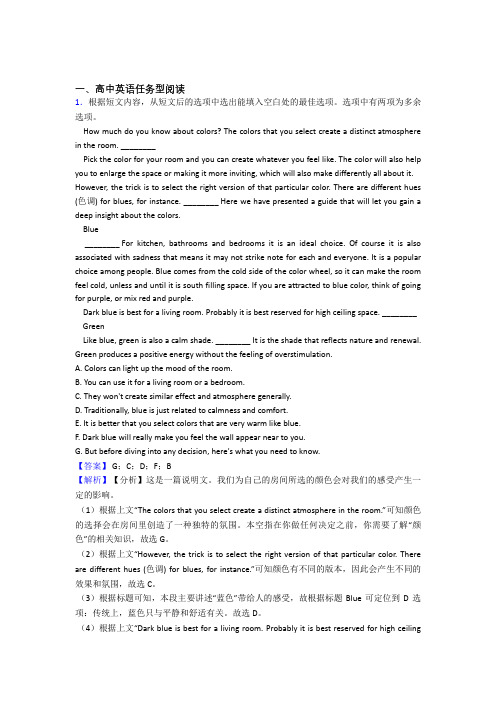
一、高中英语任务型阅读1.根据短文内容,从短文后的选项中选出能填入空白处的最佳选项。
选项中有两项为多余选项。
How much do you know about colors? The colors that you select create a distinct atmosphere in the room. ________Pick the color for your room and you can create whatever you feel like. The color will also help you to enlarge the space or making it more inviting, which will also make differently all about it. However, the trick is to select the right version of that particular color. There are different hues (色调) for blues, for instance. ________ Here we have presented a guide that will let you gain a deep insight about the colors.Blue________ For kitchen, bathrooms and bedrooms it is an ideal choice. Of course it is also associated with sadness that means it may not strike note for each and everyone. It is a popular choice among people. Blue comes from the cold side of the color wheel, so it can make the room feel cold, unless and until it is south filling space. If you are attracted to blue color, think of going for purple, or mix red and purple.Dark blue is best for a living room. Probably it is best reserved for high ceiling space. ________ GreenLike blue, green is also a calm shade. ________ It is the shade that reflects nature and renewal. Green produces a positive energy without the feeling of overstimulation.A. Colors can light up the mood of the room.B. You can use it for a living room or a bedroom.C. They won't create similar effect and atmosphere generally.D. Traditionally, blue is just related to calmness and comfort.E. It is better that you select colors that are very warm like blue.F. Dark blue will really make you feel the wall appear near to you.G. But before diving into any decision, here's what you need to know.【答案】 G;C;D;F;B【解析】【分析】这是一篇说明文。
高三英语任务型阅读测试题doc
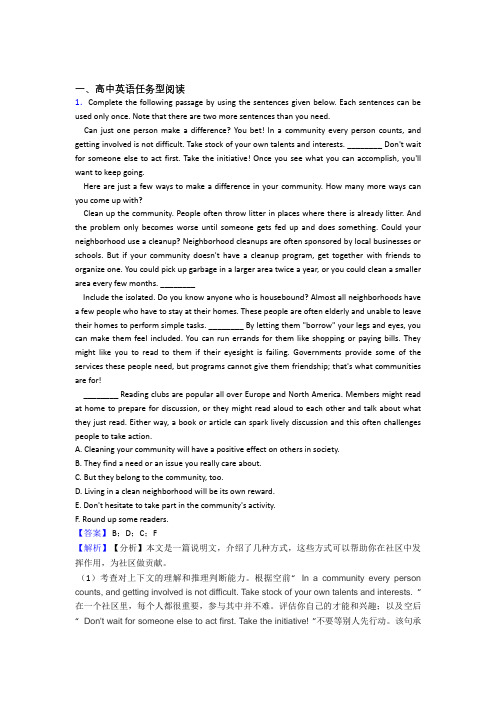
一、高中英语任务型阅读1.Complete the following passage by using the sentences given below. Each sentences can be used only once. Note that there are two more sentences than you need.Can just one person make a difference? You bet! In a community every person counts, and getting involved is not difficult. Take stock of your own talents and interests. ________ Don't wait for someone else to act first. Take the initiative! Once you see what you can accomplish, you'll want to keep going.Here are just a few ways to make a difference in your community. How many more ways can you come up with?Clean up the community. People often throw litter in places where there is already litter. And the problem only becomes worse until someone gets fed up and does something. Could your neighborhood use a cleanup? Neighborhood cleanups are often sponsored by local businesses or schools. But if your community doesn't have a cleanup program, get together with friends to organize one. You could pick up garbage in a larger area twice a year, or you could clean a smaller area every few months. ________Include the isolated. Do you know anyone who is housebound? Almost all neighborhoods have a few people who have to stay at their homes. These people are often elderly and unable to leave their homes to perform simple tasks. ________ By letting them "borrow" your legs and eyes, you can make them feel included. You can run errands for them like shopping or paying bills. They might like you to read to them if their eyesight is failing. Governments provide some of the services these people need, but programs cannot give them friendship; that's what communities are for!________ Reading clubs are popular all over Europe and North America. Members might read at home to prepare for discussion, or they might read aloud to each other and talk about what they just read. Either way, a book or article can spark lively discussion and this often challenges people to take action.A. Cleaning your community will have a positive effect on others in society.B. They find a need or an issue you really care about.C. But they belong to the community, too.D. Living in a clean neighborhood will be its own reward.E. Don't hesitate to take part in the community's activity.F. Round up some readers.【答案】 B;D;C;F【解析】【分析】本文是一篇说明文,介绍了几种方式,这些方式可以帮助你在社区中发挥作用,为社区做贡献。
上海市上海中学高三英语任务型阅读测试题百度文库
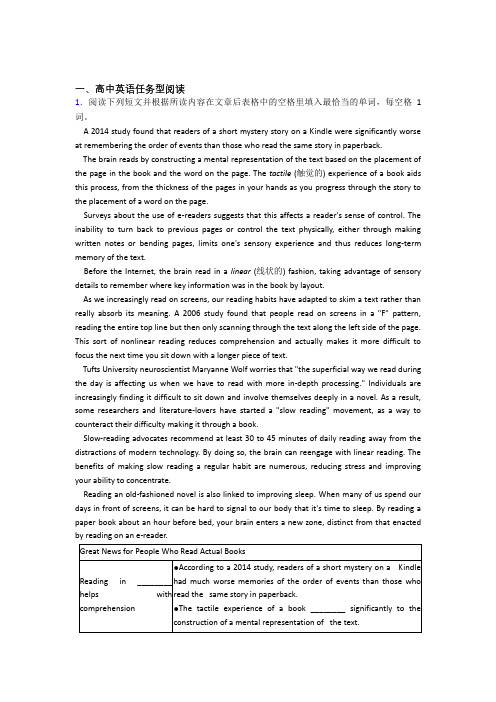
一、高中英语任务型阅读1.阅读下列短文并根据所读内容在文章后表格中的空格里填入最恰当的单词,每空格1词。
A 2014 study found that readers of a short mystery story on a Kindle were significantly worse at remembering the order of events than those who read the same story in paperback.The brain reads by constructing a mental representation of the text based on the placement of the page in the book and the word on the page. The tactile (触觉的) experience of a book aids this process, from the thickness of the pages in your hands as you progress through the story to the placement of a word on the page.Surveys about the use of e-readers suggests that this affects a reader's sense of control. The inability to turn back to previous pages or control the text physically, either through making written notes or bending pages, limits one's sensory experience and thus reduces long-term memory of the text.Before the Internet, the brain read in a linear (线状的) fashion, taking advantage of sensory details to remember where key information was in the book by layout.As we increasingly read on screens, our reading habits have adapted to skim a text rather than really absorb its meaning. A 2006 study found that people read on screens in a "F" pattern, reading the entire top line but then only scanning through the text along the left side of the page. This sort of nonlinear reading reduces comprehension and actually makes it more difficult to focus the next time you sit down with a longer piece of text.Tufts University neuroscientist Maryanne Wolf worries that "the superficial way we read during the day is affecting us when we have to read with more in-depth processing." Individuals are increasingly finding it difficult to sit down and involve themselves deeply in a novel. As a result, some researchers and literature-lovers have started a "slow reading" movement, as a way to counteract their difficulty making it through a book.Slow-reading advocates recommend at least 30 to 45 minutes of daily reading away from the distractions of modern technology. By doing so, the brain can reengage with linear reading. The benefits of making slow reading a regular habit are numerous, reducing stress and improving your ability to concentrate.Reading an old-fashioned novel is also linked to improving sleep. When many of us spend our days in front of screens, it can be hard to signal to our body that it's time to sleep. By reading a paper book about an hour before bed, your brain enters a new zone, distinct from that enacted by reading on an e-reader.miss;easy /easier;stressed /anxious /worried;sleep【解析】【分析】本文是一篇说明文,介绍了阅读纸质书籍有助于对书内容的理解,对比了阅读纸质书籍和电子书籍这两种阅读习惯,说明了慢读和阅读纸质书籍的好处。
高考英语任务型阅读训练经典题目(及答案)
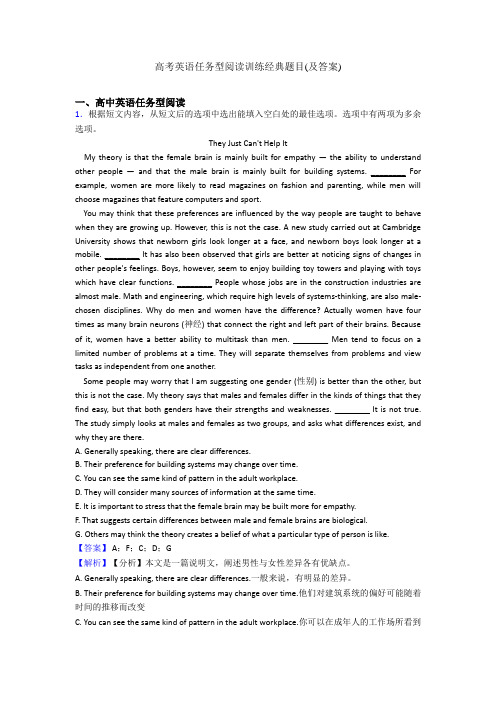
高考英语任务型阅读训练经典题目(及答案)一、高中英语任务型阅读1.根据短文内容,从短文后的选项中选出能填入空白处的最佳选项。
选项中有两项为多余选项。
They Just Can't Help ItMy theory is that the female brain is mainly built for empathy —the ability to understand other people —and that the male brain is mainly built for building systems. ________ For example, women are more likely to read magazines on fashion and parenting, while men will choose magazines that feature computers and sport.You may think that these preferences are influenced by the way people are taught to behave when they are growing up. However, this is not the case. A new study carried out at Cambridge University shows that newborn girls look longer at a face, and newborn boys look longer at a mobile. ________ It has also been observed that girls are better at noticing signs of changes in other people's feelings. Boys, however, seem to enjoy building toy towers and playing with toys which have clear functions. ________ People whose jobs are in the construction industries are almost male. Math and engineering, which require high levels of systems-thinking, are also male-chosen disciplines. Why do men and women have the difference? Actually women have four times as many brain neurons (神经) that connect the right and left part of their brains. Because of it, women have a better ability to multitask than men. ________ Men tend to focus on a limited number of problems at a time. They will separate themselves from problems and view tasks as independent from one another.Some people may worry that I am suggesting one gender (性别) is better than the other, but this is not the case. My theory says that males and females differ in the kinds of things that they find easy, but that both genders have their strengths and weaknesses. ________ It is not true. The study simply looks at males and females as two groups, and asks what differences exist, and why they are there.A. Generally speaking, there are clear differences.B. Their preference for building systems may change over time.C. You can see the same kind of pattern in the adult workplace.D. They will consider many sources of information at the same time.E. It is important to stress that the female brain may be built more for empathy.F. That suggests certain differences between male and female brains are biological.G. Others may think the theory creates a belief of what a particular type of person is like.【答案】 A;F;C;D;G【解析】【分析】本文是一篇说明文,阐述男性与女性差异各有优缺点。
高三英语任务型阅读测试题 百度文库
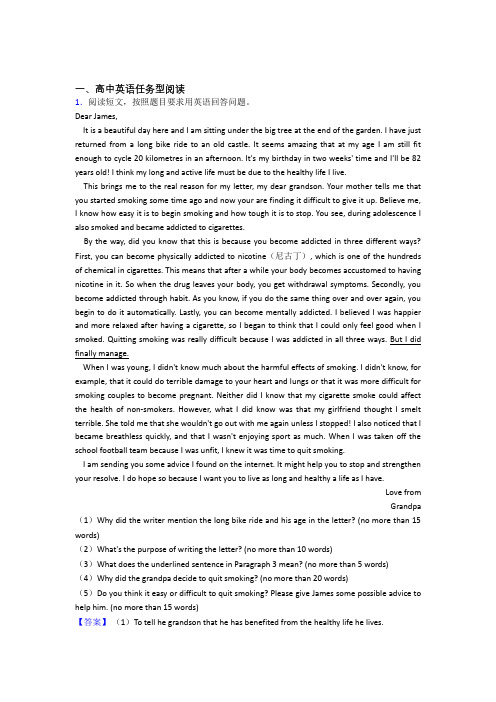
一、高中英语任务型阅读1.阅读短文,按照题目要求用英语回答问题。
Dear James,It is a beautiful day here and I am sitting under the big tree at the end of the garden. I have just returned from a long bike ride to an old castle. It seems amazing that at my age I am still fit enough to cycle 20 kilometres in an afternoon. It's my birthday in two weeks' time and I'll be 82 years old! I think my long and active life must be due to the healthy life I live.This brings me to the real reason for my letter, my dear grandson. Your mother tells me that you started smoking some time ago and now your are finding it difficult to give it up. Believe me, I know how easy it is to begin smoking and how tough it is to stop. You see, during adolescence I also smoked and became addicted to cigarettes.By the way, did you know that this is because you become addicted in three different ways? First, you can become physically addicted to nicotine(尼古丁), which is one of the hundreds of chemical in cigarettes. This means that after a while your body becomes accustomed to having nicotine in it. So when the drug leaves your body, you get withdrawal symptoms. Secondly, you become addicted through habit. As you know, if you do the same thing over and over again, you begin to do it automatically. Lastly, you can become mentally addicted. I believed I was happier and more relaxed after having a cigarette, so I began to think that I could only feel good when I smoked. Quitting smoking was really difficult because I was addicted in all three ways. But I did finally manage.When I was young, I didn't know much about the harmful effects of smoking. I didn't know, for example, that it could do terrible damage to your heart and lungs or that it was more difficult for smoking couples to become pregnant. Neither did I know that my cigarette smoke could affect the health of non-smokers. However, what I did know was that my girlfriend thought I smelt terrible. She told me that she wouldn't go out with me again unless I stopped! I also noticed that I became breathless quickly, and that I wasn't enjoying sport as much. When I was taken off the school football team because I was unfit, I knew it was time to quit smoking.I am sending you some advice I found on the internet. It might help you to stop and strengthen your resolve. I do hope so because I want you to live as long and healthy a life as I have.Love fromGrandpa (1)Why did the writer mention the long bike ride and his age in the letter? (no more than 15 words)(2)What's the purpose of writing the letter? (no more than 10 words)(3)What does the underlined sentence in Paragraph 3 mean? (no more than 5 words)(4)Why did the grandpa decide to quit smoking? (no more than 20 words)(5)Do you think it easy or difficult to quit smoking? Please give James some possible advice to help him. (no more than 15 words)【答案】(1)To tell he grandson that he has benefited from the healthy life he lives.(2)He wanted to persuade James to quit smoking.(3)He succeeded in quitting smoking.(4)Because his girlfriend left him, he began to have some healthy problems and even was taken off the football team.(5)Open.【解析】【分析】本文是一篇应用文,介绍了爷爷给孙子的一些建议,要注意进行适当的锻炼,不要吸烟,文中提到他自己以前的不良的嗜好现在也克服了,经过不断的锻炼现在虽然八十多岁了身体扔然很硬朗,建议孙子放弃吸烟,保持有健康的身体很重要。
高考英语任务型阅读训练经典题目(含答案)100
高考英语任务型阅读训练经典题目(含答案)100一、高中英语任务型阅读1.请认真阅读下面短文,并根据所读内容在文章后表格里填上一个最恰当的单词。
注意:每个空格只填1个单词。
Asthma(哮喘) is a long-lasting breathing disease that affects millions of Americans, many of whom are children. People who get asthma will suffer from lack of breath, difficulty in breathing or coughing--which are caused by the tightening of the muscles in airways. Untreated asthma can lead to poor lung function and death, but asthma can also be effectively controlled with proper treatments.Research is discovering genes that contribute to the development of asthma. This development has pointed researchers to the role of indoor and outdoor pollution as environmental factors that contribute to the increased occurrence of asthma.The Indoor PollutionIndoor pollution has increased with the developments in building materials and in heating and air conditioning systems. In addition to poisonous gases that come from paint, other materials like dust and perfumes used in household products such as washing powder are recycled continuously through the house, winter and summer.Unlike the days before central heating or before whole-house air conditioning, these materials and chemicals cannot get out of modern homes. Most often, they cause breathing problems in the members of the family with the least-developed autoimmune(自身免疫的) systems. Proper venting (通风) and use of environmentally-friendly building materials and carpeting can help reduce the presence of these chemicals.The Out door pollutionResearchers have also established outdoor pollution's role as a probable cause of asthma. Asthma has been proven to result from some fuel products. Smog and the small matters carried by it have been recognized as a factor which leads to asthma since the 19th century when London saw more and more diseases in the industrial population. Industrial pollutants and other chemicals which are produced in water treatment and open treated water like that found in the swimming pools also contribute to increased cases of asthma as well as other illnesses.Those most affected by the increase of industrial and environmental pollution are children. Although much has been done to control the levels of pollution in the US, there still remains much to do as it is a worldwide phenomenon. Until an international effort can be made to limit carbon emissions, the occurrence of environmental asthma will probably continue to increase./results/effects;Factors;caused/ increased;Besides;remain/ stay;increased/ increasing;harmful;prevented/stopped/ kept/ away/ free/ freed【解析】【分析】本文是一篇说明文,分析了哮喘产生的原因,从室内污染和室外污染两个方面来进行阐述。
高三英语任务型阅读测试题百度文库
一、高中英语任务型阅读1.Read the following passage. Fill in each blank with a proper sentence given in the box. Each sentence can be used only once. Note that there are two more sentences than you need.Screen Time: How Much Is Too Much?Many children spend a lot of time watching or playing with electronic media—from televisions to video games, computers and other devices. ________ Perhaps parents now should ease up on their concerns about screen time, at least for older boys and girls.Until last year, the American Academy of Pediatrics (AAP) suggested that children and teenagers have no more than two hours of screen time a day. It also suggests that parents balance a child's screen time with other activities.________ Christopher Ferguson, who teaches psychology at Stetson University in Florida, notes a lack of evidence supporting reports that too many hours spent playing video games or watching TV is truly harmful.Ferguson seems interested in one idea: the link between video games and violent or risky behavior. When he saw results from a recent British survey on screen time, he wanted to know more. The British study found a small negative effect—about a one percent increase—in aggression and depression among children who had six or more hours of screen time a day. ________ So, Ferguson and his team examined answers from a survey on risky behaviors. The study involved about 6,000 boys and girls in Florida, whose average age was 16.Data from this survey found that American children are also fairly resistant to the negative effects of electronic media. Among those who used screens up to six hours a day, the survey found: a 0.5 percent increase in criminal behavior; a 1.7 percent increase in signs of depression; and a 1.2 percent negative effect on school grades. ________ To further argue his point that screen time is not harmful, Ferguson adds that children should become familiar with screen technology. Electronic devices, he says, are a part of our everyday lives.A. Some negative experiences on social media can and do affect some children.B. However, some experts question claims that too much screen time is harmful.C. He wanted to see if there was a similar effect among young people in the United States.D. So, it is natural that parents should wonder about all the time children spend looking at a screen.E. The researchers found no increase in risky sex or driving behaviors, use of illegal substances or eating disorders.F. The researchers suggested that for those children, technology use might get in the way of taking part in other important activities.【答案】 D;B;C;E【解析】【分析】本文是一篇说明文,许多孩子花很多时间看或玩电子媒体——从电视到电子游戏、电脑和其他设备。
任务型阅读经典试题(含答案)百度文库
一、高中英语任务型阅读1.阅读短文,按照题目要求用英语回答问题。
My dad is a kind, gentle man, and a man of few words. Throughout my life, he offered advice rarely. But the words were always appropriate to the situation I was facing.As a teen when I struggled with making se nse of the world around me, he said, “All things are relative.” He taught me the right view of the world. When I was offered the opportunity to be a manager of an organization as an undergraduate student, I asked him for advice because he was a senior mana ger of a large company. His advice was simple, “Only when you become the manager can you have a vision for how you can make the organization better; management isn't about power and it's about leadership.” I learned what I needed was not only to be respons ible for my team but also to have leading ability. When I was feeling down, he explained, “Think that you make the wrong choices in life, sometimes.”My dad is 86 now, living on his own and enjoying life while struggling with the challenges that aging brings. He keeps a positive attitude despite long pain and the losses that come in life. Although we live quite far away from each other, we talk daily on the phone, and he shares the joys of my young family. As I tell him how we're heading off cycling or on a trip or out to play tennis, now his typical response is, “Do it while you can.” This is very important. We can't be sure of the future. My father's advice is like the ancient dictum(格言)of “ carpe diem”— seize the day and enjoy it to the fullest.M y dad rarely “lectured me”. He trusted me, and helped me when I needed help. His patience and wisdom have been true gifts in my life. As I doubt my ability and my motivation, I recall his most recent gift of wisdom, “Do it while you can”. It's enough to “just get me started”.(1)Why did the author's dad tell him “All things are relative.”? (No more than 10 words) (2)What qualities should a manager have according to the author? (No more than 5 words) (3)What is the purpose of the author's father talking with him on the phone every day? (No more than 10 words)(4)How do you understand the underlined sentence in the last paragraph? (No more than 10 words)(5)How do you feel about the ancient dictum of “carpe diem”? (No more than 20 words) 【答案】(1)To teach the author the right view of the world.(2)Both responsibility and leading ability.(3)Learning (To learn) more about the pleasure of the author's family.(4)His father's words make him take action.(5)(One possible version:) I totally agree with it, because I think one should seize the day to enjoy his life without regret.【解析】【分析】本文是一篇记叙文。
高考英语任务型阅读习题及答案 百度文库
一、高中英语任务型阅读1.阅读短文,并按照题目要求用英语回答问题。
Yellow Robot deliver snacks to your homeA robot makes its way back to a supermarket after making a delivery during a demonstration in Beijing.Along a street on the outer edges of Beijing, a yellow and black cube about the size of a small washing machine moves leisurely to its destination. This “little yellow horse” is a delivery robot, transporting daily essentials like drinks, fruit and snacks from the local store to the residents. Equipped with GPS system, cameras and radar, the robot is seen by its creator as the future of logistics(物流) in China.“The weak point is that it can't deliver directly to the door like a human.” said one customer, who does not live on the ground floor. “But it is still quite p ractical. The robot delivers relatively quickly.”The robot takes off for Chinese customers' love of cashless payments and smartphone shopping. China is the world's biggest online shopping market with more than half of its population making at least one smartphone purchase per month, according to professional services firm PricewaterhouseCoopers. Whether buying electronics, toilet paper or clothes, Chinese customers are used to simply tapping a button on their smartphone and getting a home delivery.To get a delivery via the “little yellow horse”, customers select the desired products, tap in the address and pay via their phone. Then, the supermarket staff place the items in the robot.Liu Zhiyong, founder and CEO of Zhen Robotics, which manufactures the robot, sees a bright future for his creation. “At the moment, there are 100 million packages delivered every day in China. It will be one billion in the future,” Liu said. “ There will not be enough humans to make the deliveries. We need more and more robots to fill this gap and reduce costs.” These costs are especially high in the last kilometer of a delivery.(1)What is the yellow robot equipped with? (no more than 8 words)(2)What is the weak point of the yellow robot? (no more than 12 words)(3)Why is the robot popular with Chinese people? (no more than 12 words)(4)What does the underlined word “manufactures” mean in the passage? (no more than 1 words)(5)What do you think of the invention of the yellow robot? Why? (no more than 20words) 【答案】(1)GPS system, cameras and radar.(2)It can't deliver directly to the door like a human.(3)Because of Chinese customers' love of cashless payments and smartphone shopping./Because Chinese customers love cashless payments and smartphone shopping.(4)Invents; Creates; Produces;(形式不对减一分)(5)It is very helpful. Because the robot can replace humans to make the delivers and the robot can reduce costs.【解析】【分析】本文是一篇说明文,介绍了黄色的快递机器人以及它的市场前景。
- 1、下载文档前请自行甄别文档内容的完整性,平台不提供额外的编辑、内容补充、找答案等附加服务。
- 2、"仅部分预览"的文档,不可在线预览部分如存在完整性等问题,可反馈申请退款(可完整预览的文档不适用该条件!)。
- 3、如文档侵犯您的权益,请联系客服反馈,我们会尽快为您处理(人工客服工作时间:9:00-18:30)。
一、高中英语任务型阅读1.Directions: Read the following passage. Fill in each blank with a proper sentence given in the box. Each sentence can be used only once. Note that there are two more sentences than you need.A problem shared can be a problem doubledPeople discuss their problems with friends in the hope that they'll gain some idea on how to solve them. And even if they don't find a way to solve their problems, it feels good to let off some steam. Indeed, having close friends to trust is a good relief against poor mental health. ________ The term psychologist's use for negative problem sharing is "co-rumination". Co-rumination is the mutual encouragement to discuss problems too much, repeatedly going over the same problems, expecting future problems and focusing on negative feelings. It is more about keeping talking about problems than solving them. ________ In a study involving children aged seven to 15 years of age, researchers found that co-rumination in both boys and girls is associated with "high-quality" and close friendships. However, in girls, it was also associated with anxiety and depression (the same association was not found with the boys).If we look at the theory behind why individuals ruminate, it may shed some light on why friends co-ruminate. ________ So if two people believe rumination is beneficial, then working together to co-ruminate to find answers may seem like a useful thing to do, as two heads may appear better than one. But focusing on problems and negative emotion together can increase negative beliefs and moods — and result in a greater need to co-ruminate.Traditionally, therapy has not prioritised handling rumination or co-rumination directly as maintaining factors in psychological problems. Instead, approaches such as cognitive behavioral therapy (CBT) have aimed to challenge only the content of rumination. Humanistic approaches such as counselling have provided conditions to potentially ruminate on the content of problems. And psychodynamic (心理动力的) approaches such as psychoanalysis have aimed to analyze the content of rumination.________ But if this occurs in therapy, a strong therapeutic relationship may well be a positive outcome of co-rumination — regardless of whether the client's symptoms improve or not.And, on the social side, discussing problems with friends doesn't always have to lead to worsening mental health, as long as the discussion involves finding solutions and the person with the problem acts on those solutions. Then, relationships can be positive and beneficial to both parties, and a problem shared can really be a problem halved.A. According to a leading theory on rumination, people believe that it will help them find answers and make them feel better.B. How you co-ruminate matters too.C. Focusing on the content of rumination runs the risk of fostering co-rumination between client and therapist.D. How problems are discussed, though, can be the difference between halving a problem or doubling it.E. Co-rumination with work colleagues can increase the risk of stress and tiredness, one studysuggests.F. Research shows that co-rumination is a double-edged sword.【答案】 D;F;A;C【解析】【分析】本文是一篇议论文。
与朋友过多地讨论问题,反复讨论同样的问题,期待未来的问题,并关注负面情绪,这种被称为"共同反刍"。
共同反刍是一把双刃剑,可能会让问题减半,也可能会让问题加倍。
(1)考查对上下文的理解和推理判断能力。
根据空前"Indeed, having close friends to trust is a good relief against poor mental health."可知拥有亲密的朋友确实可以很好地缓解心理健康状况。
后文,也就是从第二段开始作者介绍了共同反刍的涵义和利弊。
空格处需要承上启下,D. How problems are discussed, though, can be the difference between halving a problem or doubling it."但是,如何讨论问题可能是将问题减半或加倍问题的区别。
"切题,故选D。
(2)考查对上下文的理解和推理判断能力。
根据空后"In a study…with anxiety and depression (the same association was not found with the boys)."可知下文介绍了一项涉及7至15岁儿童的研究,研究发现男孩和女孩的共同反刍与"高质量"和亲密的友谊有关。
然而,在女孩中,它也与焦虑和抑郁有关。
说明共同反刍既有利也有弊。
承上启下, F. Research shows that co-rumination is a double-edged sword."研究发现共同反刍是把双刃剑"切题。
F项的researches与后文的the study相呼应。
故选F。
(3)考查对上下文的理解和推理判断能力。
根据空前"If we look at the theory behind why individuals ruminate, it may shed some light on why friends co-ruminate."可知作者想用个人反刍的理论来更好地解释朋友间的共同反刍。
承接上文, A. According to a leading theory on rumination, people believe that it will help them find answers and make them feel better."根据反刍的主要理论,人们相信反刍会帮助他们找到答案并让他们感觉更好。
"切题。
A项 a leading theory on rumination与前文中的the theory behind why individuals ruminate相呼应。
